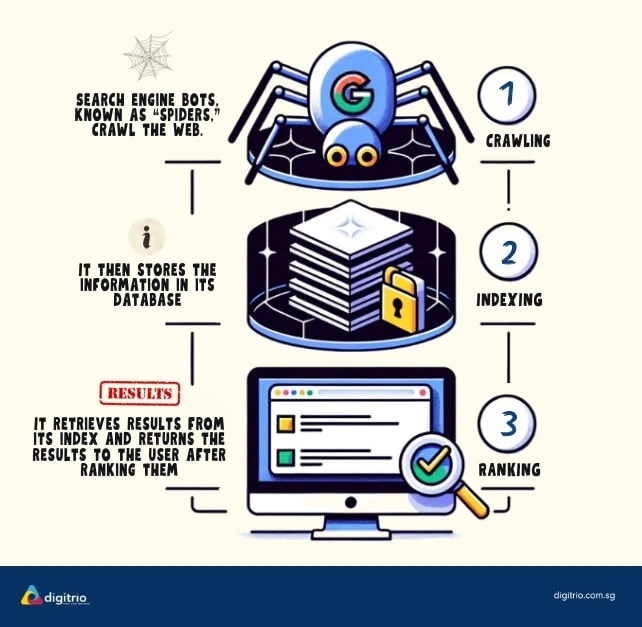Are you invisible to search engines? Discover the steps to determining if your website is SEO-friendly and increase visibility now!

Image courtesy of via DALL-E 3
Table of Contents
- Introduction to SEO-Friendly Websites
- Easy Steps to Check Your Website’s SEO-Friendliness
- Using Keywords Smartly
- Building High-Quality Links
- Ensuring a Safe and Secure Website
- Making Sure Your Website is Easily Navigable
- Analyzing Your Website’s Data
- Keeping Up with SEO Trends
- Conclusion
- Frequently Asked Questions (FAQs)
Introduction to SEO-Friendly Websites
Have you ever wondered how websites appear on the first page of Google when you search for something? The secret lies in SEO, which stands for Search Engine Optimization. In simple terms, SEO helps websites be found easily by search engines like Google. Let’s dive into what it means to have an SEO-friendly website and why it is important.
What is SEO?
SEO is like a magic formula that helps websites show up when people search for things online. It’s all about using the right words and tricks to make sure your website gets noticed by search engines. Without SEO, your website might get lost in the vast digital world!
Why Do Websites Need to Be SEO-Friendly?
Imagine you have a fantastic website with amazing content, but no one can find it. That’s where SEO comes in. By making your website SEO-friendly, you increase the chances of people discovering your website when they search for something related to what you offer. Being SEO-friendly is like putting up a big sign that says, “Come and visit me!”
Easy Steps to Check Your Website’s SEO-Friendliness
When it comes to checking if your website is SEO-friendly, the first step is to evaluate your content. Good content is crucial because it helps search engines understand what your website is about. Make sure your content is helpful, informative, and includes relevant keywords and phrases that people might use when searching online.
Check the Website’s Loading Speed
Another important aspect to consider is the loading speed of your website. A slow-loading site can turn visitors away and negatively impact your SEO. Use tools like Google’s PageSpeed Insights to check your website’s loading speed and get suggestions on how to improve it.
Examine the Mobile Friendliness
In today’s mobile-centric world, it’s essential for your website to look good and function well on mobile devices. To check if your website is mobile-friendly, you can use Google’s Mobile-Friendly Test. This tool will analyze your site and provide recommendations on how to make it more mobile-responsive.
By following these simple steps, you can ensure that your website is optimized for search engines and easily discoverable by your target audience.
Using Keywords Smartly
Keywords are important words that people use when searching online. These words help search engines like Google understand what a website is about. When someone searches for something using specific keywords, the search engine tries to match those keywords with the content on websites to provide relevant results.

Image courtesy of www.thedallasseocompany.com via Google Images
Using Keywords in Your Content
When creating content for your website, it’s essential to incorporate relevant keywords naturally. This means using keywords in a way that makes sense within the context of your text. Avoid stuffing your content with too many keywords, as this can make it sound unnatural and unappealing to readers.
Instead, focus on using keywords strategically in headings, subheadings, and throughout your content to signal to search engines what your page is about. By smartly integrating keywords into your content, you can improve your website’s visibility and ranking in search results.
Building High-Quality Links
Building high-quality links is an essential component of improving your website’s SEO. But what exactly are high-quality links, and how can they benefit your site?
What Are High-Quality Links?
High-quality links are links from reputable websites that point back to your site. These links act as a vote of confidence in your content, signaling to search engines that your website is trustworthy and relevant. When authoritative sites link to yours, it helps boost your site’s credibility and visibility in search engine results.
Getting High-Quality Links
There are several strategies you can use to acquire high-quality links for your website. One effective method is through guest posting, where you contribute valuable content to other websites in exchange for a backlink to your site. Another option is to collaborate with other websites in your niche to exchange links or create joint content.
Additionally, creating shareable content that naturally attracts links can help boost your link profile. Infographics, research studies, and in-depth guides are types of content that tend to attract links from other sites.
Remember, it’s not just about the quantity of links but the quality. Focus on building links from trusted sources that are relevant to your industry. Avoid questionable link-building practices, as search engines can penalize sites that engage in manipulative tactics.
Ensuring a Safe and Secure Website
An SSL certificate is like a digital passport that authenticates the identity of a website and encrypts information sent to the server. It helps to create a secure connection between the website and its visitors, ensuring that data shared on the site is protected from unauthorized access. Having an SSL certificate is crucial for website security and also plays a significant role in SEO.

Image courtesy of venngage.com via Google Images
Keeping Your Website Updated
Regularly updating your website’s software, plugins, and other components is essential for maintaining security. Updates often include patches for vulnerabilities that hackers could exploit to gain access to your site. By keeping everything up to date, you reduce the risk of security breaches and ensure that your website is a safe and secure place for visitors to explore.
Making Sure Your Website is Easily Navigable
Having a website that is easy to navigate is essential for keeping visitors engaged and improving your site’s SEO. When people can easily find what they’re looking for, they are more likely to stay on your site longer and explore more pages. Here are some important tips to ensure that your website is easily navigable:
Organizing Your Website’s Menu
One of the first things visitors look for on a website is the menu. It’s like a roadmap that helps them navigate through different sections and pages. Make sure your menu is clear, simple, and organized logically. Use descriptive labels that make it easy for visitors to understand where each link will take them. Avoid overwhelming them with too many options, as simplicity is key to a user-friendly experience.
Using Internal Links
Internal links are links that connect one page of your website to another. By strategically placing internal links within your content, you can guide visitors to related or important pages on your site. This not only helps visitors discover more valuable information but also improves your site’s SEO. Search engines like Google use internal links to crawl and index your site more effectively, boosting your overall search visibility.
Analyzing Your Website’s Data
Understanding your website’s data is crucial for improving its SEO performance. By analyzing the data, you can gain valuable insights into how visitors interact with your site and make informed decisions to enhance its visibility and user experience.

Image courtesy of digitrio.com.sg via Google Images
Using Website Analytics Tools
Website analytics tools like Google Analytics provide detailed information about your site visitors, including how they found your site, which pages they visited, how long they stayed, and more. By leveraging these tools, you can track key metrics to assess the effectiveness of your SEO efforts.
Interpreting Data for SEO Improvements
Once you have collected data from analytics tools, it’s essential to interpret the findings to identify areas for improvement. For example, if you notice high bounce rates on certain pages, you may need to optimize their content or user experience. By analyzing the data, you can tailor your SEO strategies for better performance.
Keeping Up with SEO Trends
Staying current with the latest SEO trends is crucial to ensure that your website remains visible and competitive in search engine results. Search engines like Google frequently update their algorithms, so it’s important to adapt your SEO strategies accordingly.
Following SEO Blogs and News
To keep up with the ever-changing landscape of SEO, it’s helpful to follow reputable blogs and news sources dedicated to this topic. Websites like Moz, Search Engine Land, and Google Webmaster Central provide valuable insights and updates on the latest SEO trends. By staying informed, you can implement timely strategies to improve your website’s search engine ranking.
Adapting to Changes
When search engines make updates to their algorithms, it’s essential to adapt your SEO tactics to align with these changes. Whether it’s a shift towards prioritizing mobile-friendly websites or placing more emphasis on user experience, staying flexible and adaptable is key to maintaining a strong online presence. By monitoring industry developments and adjusting your SEO approach accordingly, you can ensure that your website remains optimized for search engines.
Conclusion
In conclusion, ensuring that your website is SEO-friendly is crucial for its visibility and success online. By following the steps outlined in this blog post, you can check the SEO-friendliness of your website and make necessary improvements to attract more visitors and potential customers. Remember, SEO is about making your website more visible to search engines like Google so that people can easily find it when they search for relevant keywords.

Image courtesy of www.thehoth.com via Google Images
By creating quality content with relevant keywords, optimizing for mobile devices, building high-quality links, securing your website, improving navigation, analyzing data, staying up-to-date with SEO trends, and regularly checking your website’s SEO-friendliness, you can enhance your online presence and reach a wider audience. These efforts will not only benefit your website’s ranking on search engines but also provide a better user experience for your visitors.
Don’t overlook the importance of SEO for your website’s success. It’s an ongoing process that requires continuous monitoring and improvement. By implementing the strategies mentioned in this blog post, you can take the necessary steps to ensure that your website is SEO-friendly and well-positioned to attract organic traffic and achieve your online goals.
Frequently Asked Questions (FAQs)
What If My Website Isn’t SEO-Friendly?
If you find that your website isn’t SEO-friendly, don’t worry! There are steps you can take to improve its optimization. Start by looking at the content on your website. Make sure it is relevant, informative, and includes keywords that people are likely to search for. You can also check the loading speed of your website and ensure that it is mobile-friendly. Additionally, consider building high-quality links from reputable websites to improve your site’s credibility. By following these steps, you can make your website more SEO-friendly and increase its chances of being found by search engines.
How Often Should I Check My Website’s SEO?
Checking your website’s SEO regularly is essential to ensure it stays optimized and competitive. It is recommended to perform SEO checks on your website at least once a month. This will help you stay updated on any changes that need to be made in terms of content, keywords, links, and overall website performance. By monitoring your website’s SEO regularly, you can identify and address any issues promptly, improving your website’s visibility and performance in search engine results.







